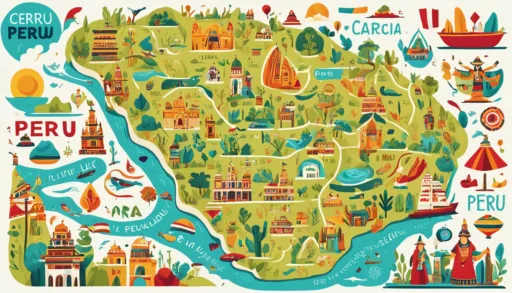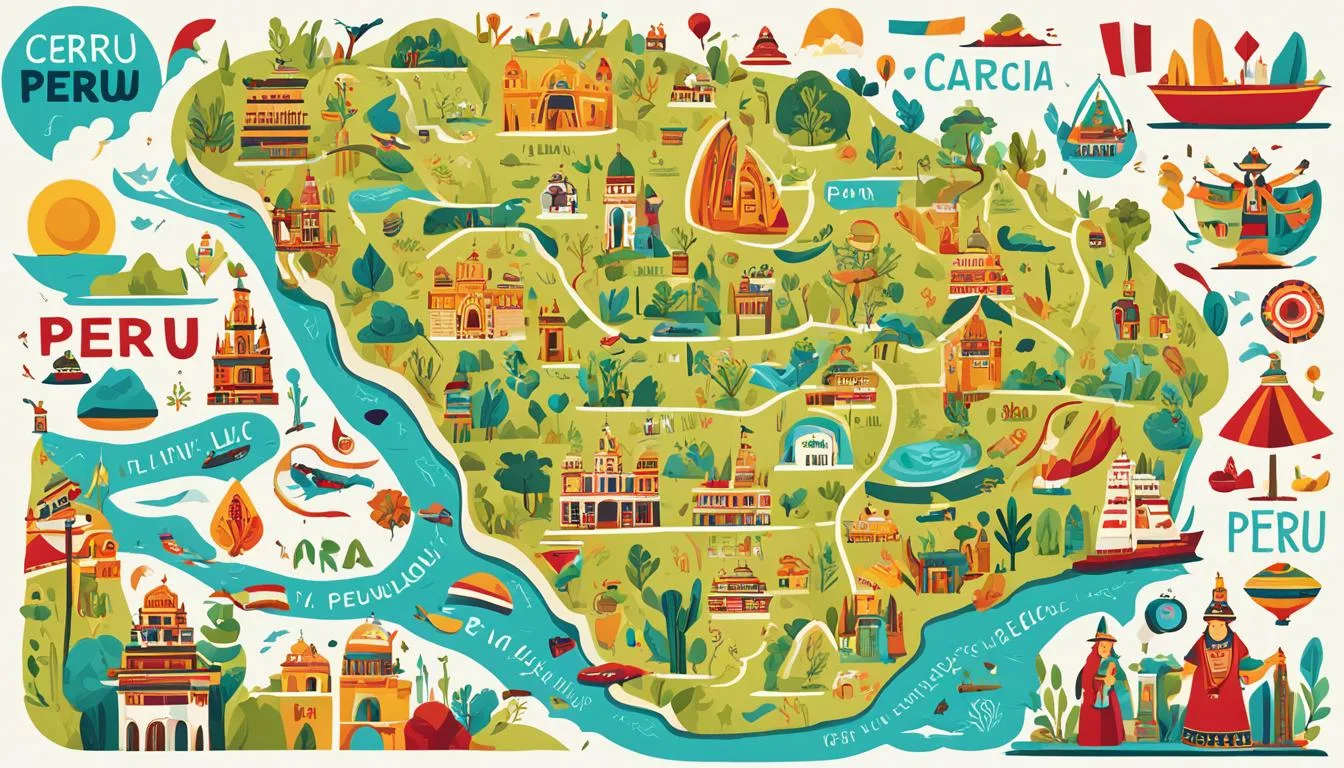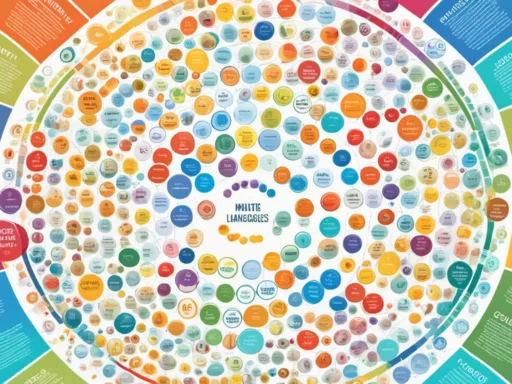Among the tapestries of culture and topography that make up South America’s portrait, an unexpected fact emerges from Peru: over 26% of its population speaks a native language other than Spanish. This linguistic mosaic has solidified Peru’s standing as a bastion of cultural diversity, with the languages spoken in Peru spanning beyond the well-known Spanish to a vast array of indigenous voices—each echoing the country’s rich heritage. A myriad of languages echo in the Andes, whisper through the Amazon, and resound along the bustling streets of Lima, painting a vivid picture of Peru’s cultural complexity. The linguistic diversity of Peru is not just a representation of its fragmented geography, but a testament to the resilience and adaptive spirit of the Peruvian peoples.
In a country where the echoes of Incan grandeur still resonate through its valleys and highlands, the dominion of the Spanish language intertwines with the indigenous tongues such as Quechua and Aymara, securing an identity as irresistible as it is distinct. Focusing on the fabric that weaves the nation together, the myriad Peruvian languages offer a glimpse into the living history and evolving culture that is as splendid as the famed ruins of Machu Picchu.
Key Takeaways
- Peru’s population showcases a significant percentage of indigenous language speakers.
- Spanish, while widely spoken, is just one thread in the complex linguistic fabric of the nation.
- Languages such as Quechua and Aymara enjoy co-official status, enriching Peru’s linguistic heritage.
- The geographical distribution of languages in Peru speaks volumes of its historical and cultural diversity.
- Understanding the languages spoken in Peru is key to appreciating the country’s multifaceted identity.
- Multilingualism in Peru reflects a commitment to preserving a diverse cultural landscape.
- The constitutional recognition of indigenous languages underscores the importance of linguistic plurality.
Linguistic Landscape of Peru
The intricate tapestry of Peruvian languages is highlighted by a remarkable breadth of multilingualism in Peru. This linguistic phenomenon is deeply rooted in the nation’s culture and geography, as evidenced by the complex interplay between Spanish in Peru and the rich array of indigenous languages Peru is known for. Let’s delve into the prevalence of multilingualism and the geographic distribution of languages across the nation, revealing the true essence of Peru’s vibrant language landscape.
The Prevalence of Multilingualism
Peru showcases an exceptional case of linguistic diversity, setting a global standard for multilingual societies. The nation boasts an estimated 50 to 44 distinct languages, with dialects further enriching this variety. This multilingual fabric spans various communicative threads, connecting communities through shared vernaculars, while still preserving the uniqueness of each linguistic heritage.
Geographic Distribution of Languages
While urban centers like Lima are primarily Spanish-speaking, the highland and Amazonian regions tell a different story. There, indigenous and Spanish languages weave an intricate bilingual and sometimes trilingual society, as the table below illustrates:
| Region | Dominant Languages | Notable Indigenous Languages |
|---|---|---|
| Amazon Rainforest | Spanish, Indigenous Languages | Approximately 40 languages in 17 families |
| Andean Highlands | Spanish, Quechua | Quechua Varieties, Aymara |
| Urban Centers | Primarily Spanish | Lesser presence of Indigenous Languages |
| Rural Areas | Spanish, Quechua, Other Indigenous Languages | Diverse Amazonian Languages |
The map of Peru showcases exciting patterns of linguistic usage. As one traverses from the coastal cities to the remote valleys and forests, the linguistic landscape transforms, blending voices of the past with the tongues of today. Indeed, the thriving multilingualism in Peru is more than just a characteristic — it’s the pulsating heart of the nation’s cultural identity.
Official Languages of Peru
The linguistic heritage of Peru is as diverse as its landscapes, with languages ranging from the widely spoken Spanish to the historically significant indigenous tongues like Quechua and Aymara. The intertwining of these languages reflects the country’s commitment to preserving its rich cultural mosaic.
Spanish: The Dominant Language
With roots tracing back to the colonial era, Spanish in Peru has emerged as the primary mode of communication, instruction, and administration, solidifying its place as the foremost official language of the nation. Its prevalence is most evident in educational systems, media, and urban centers, making it a pivotal element in the country’s sociolinguistic fabric.
Quechua and Aymara: Official Indigenous Languages
In regions where indigenous populations are prevalent, Quechua in Peru and Aymara in Peru hold equal official status, reflective of the nation’s respect for linguistic diversity. These languages not only serve as a bridge for communication among ethnic communities but also play a fundamental role in the preservation of Peru’s historical and cultural narratives.
| Language | % of Population | Official Status | Geographic Concentration |
|---|---|---|---|
| Spanish | 94.4% | National | Throughout Peru |
| Quechua | 13.9% | Regions where it predominates | Andes, especially central and southern |
| Aymara | 1.7% | Regions where it predominates | Andes, mainly around Lake Titicaca |
The linguistic policies in Peru stand as a testament to its dedication to respecting and upholding the voices of its varied communities, signifying an all-embracing perspective that is central to the nation’s identity.
Indigenous Languages: A Glimpse into Peru’s Cultural Heritage
The linguistic diversity in Peru spans beyond the well-known Spanish, Quechua, and Aymara, painting a broad canvas of distinct dialects that are intimately connected with the country’s cultural heritage. Peru’s complex geography, including the formidable Andes and the lush Amazon rainforest, has been a significant influence on the proliferation of indigenous languages. This has given rise to an array of languages and dialects that embody Peru’s rich ancestral and contemporary life.
The Impact of Geography on Language Diversity
Geography has played a fundamental role in shaping the diversity of languages within Peru. The natural barriers created by the Andes have led to the cultural and linguistic isolation of communities, fostering the development of unique languages. This diversity highlights the broader issue of language preservation and the importance of understanding how topography and environment affect linguistic development in regions like Peru.
Prominent Indigenous Languages
In the quest to recognize and understand the indigenous languages of Peru, it becomes clear that these tongues serve as a living link to the nation’s cultural heritage. Below is a glimpse into just a few of these languages that reflect the linguistic diversity of Peru.
| Language | Language Family | Primary Location | Speakers |
|---|---|---|---|
| Asháninka | Arawakan | Central-Eastern Peru | Approx. 80,000 |
| Aguaruna | Jivaroan | Northern Peruvian Amazon | Approx. 45,000 |
| Jaqaru | Aymaran | Yauyos Province | Fewer than 2,000 |
| Kawki | Cauqui Quechua | Ankash Region | Nearly extinct |
Although languages like Jaqaru and Kawki face challenges of diminishing numbers, efforts continue to study and revitalize these significant elements of Peru’s cultural heritage. The preservation of these languages is paramount to maintaining the vast quilt of traditions, stories, and knowledge systems that constitute the spirit of Peru.
languages spoken Peru: Understanding the Multicultural Tapestry
The linguistic landscape of Peru is a vibrant patchwork of dialects and languages spread across its diverse terrain. This mosaic is not just a feature of cultural identity but a dynamic entity reflecting the country’s multifaceted human geography.
From Coast to Jungle: A Varied Linguistic Scene
In the coastal expanses, Spanish prevails, painting the urban narratives with its Latinate strokes. Conversely, the dense greenery of the Amazon shelters a wealth of indigenous dialects, echoing ancestral wisdom and contemporary struggles. The Peruvian highlands sing a different tune with Quechua and Aymara reverberating through the Andean air, a testament to the country’s rich pre-Columbian history and enduring indigenous presence.
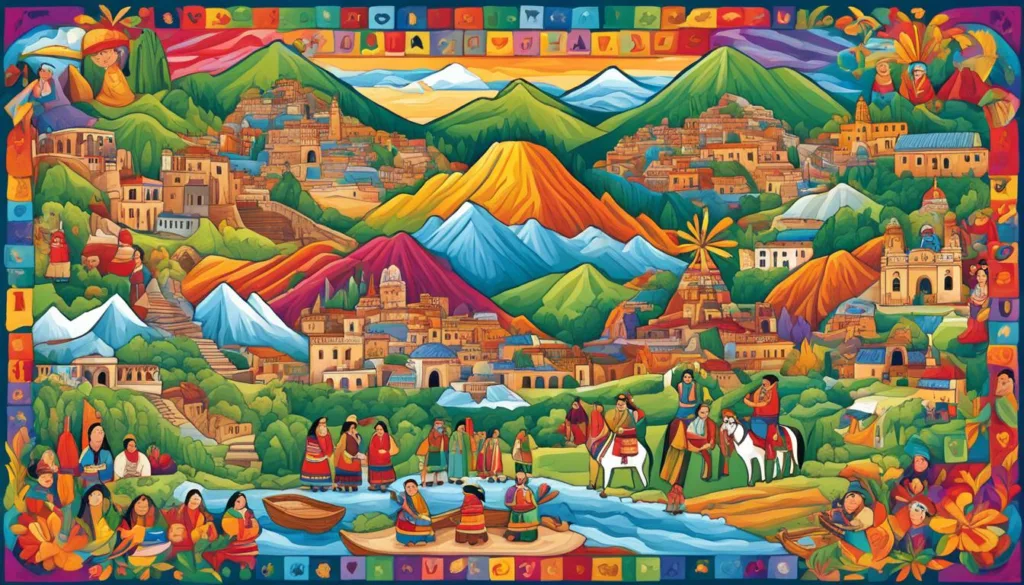
Language Vitality and Preservation Efforts
While many languages flourish, others cling to survival. The urgency to preserve the linguistic diversity of Peru is palpable. A synergy of government initiatives and local movements aims to breathe life into the varied tongues of Peru’s populace.
| Language | Number of Speakers | Vitality Status | Preservation Actions |
|---|---|---|---|
| Quechua | Approximately 3.6 million | Thriving | Bilingual education programs |
| Aymara | Approximately 440,000 | Stable | Cultural festivals and radio broadcasts |
| Asháninka | Approximately 96,000 | Vulnerable | Literacy materials and advocacy |
| Aguaruna | Approximately 45,000 | Endangered | Documentation and language courses |
In alignment with this commitment, language preservation in Peru is not merely a legislative act but a heartfelt quest to sustain the core of a people’s heritage. Every effort, from documentation to education, extends a lifeline to the languages at risk of fading into the annals of history.
The essence of Peru’s identity thrives through the tongues of her children; may the chorus of diverse voices continue to resonate for generations to come.
Spanish in Peru: More Than Just a Lingua Franca
Exploring the rich linguistic landscape of Spanish in Peru leads to a fascinating discovery that this language is far more than a mere means of communication. It sits at the heart of Peru’s cultural diversity, morphing into distinct identities across various regions.
Variations of Spanish Across the Regions
From the Andes to the Amazon, the Spanish language in Peru exhibits a kaleidoscope of dialects, each with its own unique characteristics and influences. For instance, in the Andes, the intricate interweaving of local indigenous words into the Spanish tapestry flavors everyday conversation, while in coastal areas, the language carries the echoes of historical migrations. This makes the pursuit of understanding Andean Spanish and Amazonic Spanish more than just an academic endeavor—it’s a journey through Peru’s living history.
Andean and Amazonic Spanish Dialects
The linguistic diversity of Peru is further showcased within each region’s take on Spanish. Andean Spanish is particularly noteworthy for its integration of Quechua and Aymara elements, a testament to the endurance of indigenous cultures. To provide a vivid snapshot of these variations, consider the following table which details specific attributes that distinguish Andean and Amazonic Spanish dialects from one another.
| Characteristic Features of Spanish Dialects in Peru | |
|---|---|
| Andean Spanish | Amazonic Spanish |
| Incorporation of Quechua and Aymara lexicon | Linguistic blend with various Amazonian languages |
| Unique pronunciation of ‘r’ at the end of words | Mestizo influence leading to a mix of indigenous and Spanish qualities |
| Use of the Spanish vosotros form | Prevalent usage of tú for second-person singular |
| Retention of the aspirated ‘s’ sound | Softening of ‘c’ and ‘z’ sounds akin to seseo |
It’s clear that the Spanish spoken within Peru’s borders is a dynamic entity, flavored by the country’s vast cultural and geographical tapestry. Whether it be the Andean highlands or the lush expanse of the Amazon, the language carries a myriad of narratives, each adding depth and color to the nation’s collective voice.
The Rich Palette of Quechua Varieties in Peru
As a testament to the vibrant linguistic diversity Peru is known for, the array of Quechua varieties is unparalleled. Deeply woven into the fabric of the nation, Quechua in Peru maintains its prestigious status, echoing the voices of the Inca Empire through the Andean highlands and beyond. This significant tongue is more than a mode of communication—it’s a living chronicle of Peruvian ancestry.
Quechua’s Historical Significance
Quechua’s influence stretches back to its days as the lingua franca under Incan rule. Today, it upholds its notability, bridging past and present. Used by millions, Quechua has endured the test of time and remains a robust element of Peru’s national identity.
Regional Dialects and Their Interconnectedness
Peru’s Quechua is a collage of dialects, each with their unique linguistic threads yet interlaced through common heritage. The country’s geography has birthed distinct variations—some so different that they may present challenges in mutual understanding, yet all contribute to the greater Quechua mosaic.
Let’s delve into a comparative view of some principal Quechua dialects in Peru:
| Quechua Variety | Geographic Region | Number of Speakers (Estimated) | Notable Characteristics |
|---|---|---|---|
| Southern Quechua | Cusco, Arequipa, Puno | Approx. 3-4 million | Considered the most widespread dialect |
| Ancash Quechua | Ancash Region | Approx. 1 million | Known for distinctive phonological features |
| Huánuco Quechua | Huánuco Region | Tens of thousands | Retains many archaic features |
| Ayacucho Quechua | Ayacucho Region | Approx. 500,000-800,000 | Exhibits a conservative grammar |
Reflecting on these dialects, it’s clear that understanding the Quechua varieties is key to appreciating the intricate linguistic diversity Peru offers, and recognises Quechua’s continuous role in shaping the cultural tapestry of the nation.
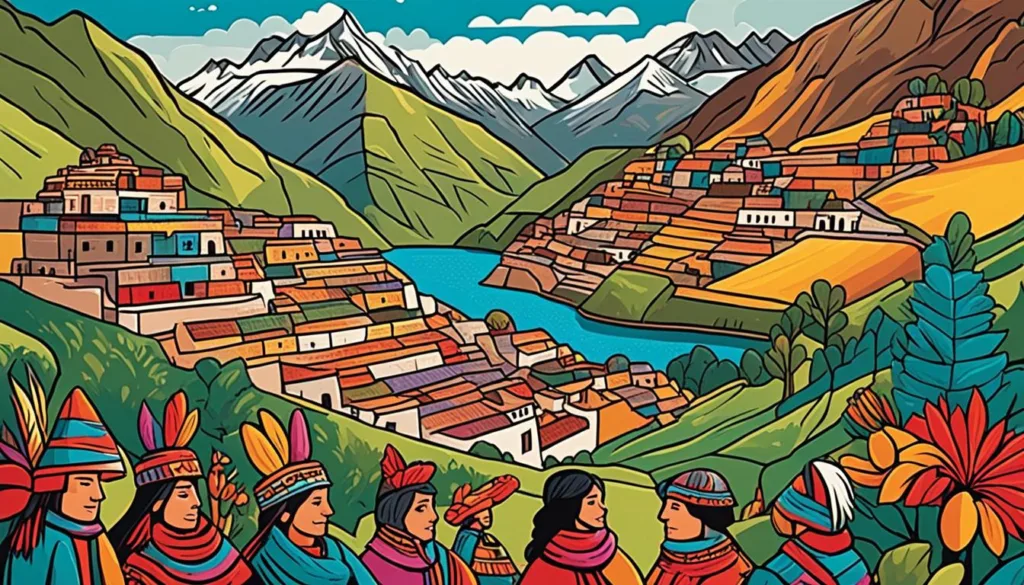
Aymara in Peru: An Ancient Tongue’s Present Status
The Aymara language, with its venerable roots nestled in the Andes, continues to be a hallmark of Peru’s impressive linguistic diversity. As an emblem of cultural resilience, Aymara has withstood the pressures of time and modern influences to maintain a robust foothold among the indigenous languages of Peru. Let’s delve into the geographical foundations and contemporary demographics of Aymara speakers to appreciate its role in Peru’s rich tapestry of languages.
Aymara’s Geographical and Cultural Roots
Recorded history reveals the Aymara people as one of the oldest residents around Lake Titicaca, establishing a legacy that predates the Inca civilization. The storied shores of the world’s highest navigable lake remain the nerve center for the Aymara language. The Kallawaya, a traveling healer group, and the Yampara, with their distinctive cultural practices, are among the communities tightly interwoven with the Aymara language, contributing to the linguistic diversity Peru celebrates today.
Current Demographics of Aymara Speakers
A census of languages within Peru paints a portrait of Aymara’s contemporary face, with around 1.7% of the populace embracing it as their mother tongue. This linguistic minority, representing thousands of Aymara speakers, is a testament to the language’s fortitude and the enduring vibrancy of its community. Below is a table illustrating the distribution and demographics of Aymara speakers in the key regions of Peru.
| Region | Percentage of Aymara Speakers | Significant Cultural Practices |
|---|---|---|
| Puno | 60% | Serenata a la Ciudad de Puno, Candelaria Festival |
| Tacna | 23% | La Fiesta de las Cruces, Traditional Aymara Weddings |
| Moquegua | 11% | Virgen de Chapi Pilgrimage, Aymara New Year Celebrations |
| Metropolitan Lima | 2% | Cultural Fairs, Indigenous Language Education Programs |
Despite these figures, the essence of Aymara extends beyond mere numbers—it is woven into identity and tradition, influencing dances, ceremonies, and the daily lives of many Peruvians. With concerted efforts in language preservation, Aymara will continue to inspire future generations, upholding Peru’s commitment to its indigenous languages and linguistic diversity.
Other Indigenous and Minority Languages of Peru
Peru’s rich linguistic fabric extends far beyond its official languages, weaving together a diverse array of indigenous and minority languages that mirror the country’s multifaceted cultural identity. The voices of these languages speak volumes about Peru’s intricate linguistic diversity, yet they face serious challenges to their sustained vibrance and survival. Government efforts and cultural institutions strive to protect these precious linguistic threads, essential for maintaining the colorful and diverse spectrum that is quintessentially Peruvian.
Threatened Languages and Dialects
Among the mosaic that forms Peru’s linguistic landscape, several indigenous languages are in a critical state, on the cusp of silence. With globalization and the predominant use of Spanish and other major indigenous languages like Quechua and Aymara, smaller languages encounter numerous obstacles. The ongoing work towards preservation is vital, as each disappearing dialect represents not only a loss of words but an irreplaceable pattern in the tapestry of human knowledge and heritage.
Notable Minority Language Influences
Amidst the backdrop of predominantly indigenous communications, Peru also acknowledges the contributions from minority language communities that have settled within its borders. Historical waves of immigration introduced languages such as French, Arabic, Hindi, Chinese, Japanese, Italian, and Portuguese, each adding unique flair to the nation’s linguistic diversity. These languages contribute to the vibrant marketplace of ideas and expressions in Peru, with the government and various organizations committed to nurturing this linguistic pluralism.
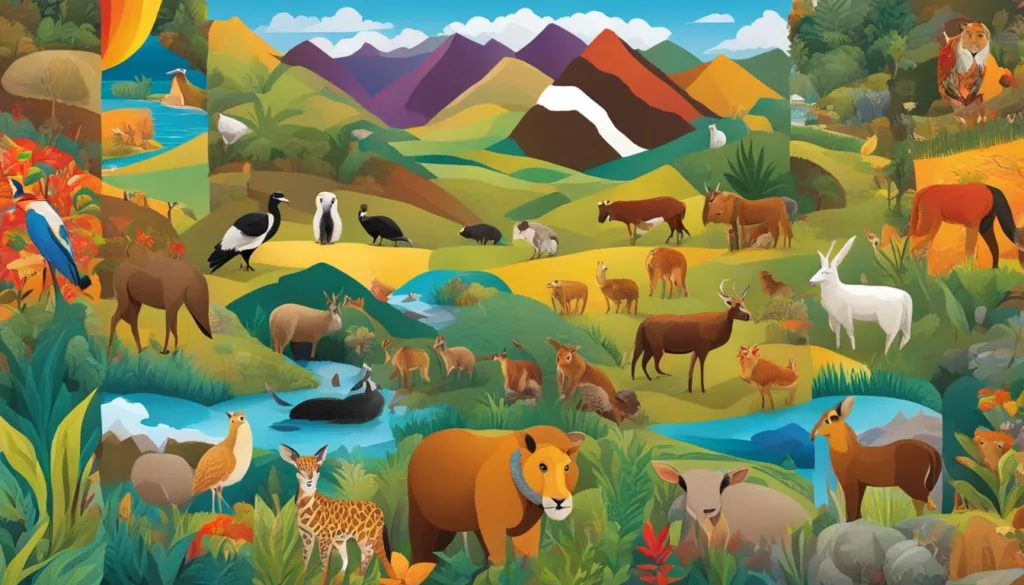
| Language | Number of Speakers | Regions | Status |
|---|---|---|---|
| Asháninka | Approx. 96,000 | Central Eastern Peru | Vulnerable |
| Aguaruna | Approx. 45,000 | Northern Peruvian Amazon | Definitely Endangered |
| Shipibo-Conibo | Approx. 26,000 | Ucayali Region | Vulnerable |
As we delve into the intricate world of Peru’s minority languages, it is apparent that resilience and revitalization are key for nurturing these pillars of cultural identity. Celebrating and supporting these languages will continue to enrich Peru’s storied traditions and acknowledge the profound history of its people.
Peru’s Efforts in Language Education and Preservation
In recognition of the invaluable role that language plays in preserving cultural heritage and national identity, Peru is actively enhancing its educational landscape to encourage language retention and proficiency. At the forefront of these initiatives is the emphasis on language education in Peru, where strategic approaches are bolstered by supportive legislation and public policies designed to maintain the country’s linguistic diversity.
Implementing Bilingual Education
The Peruvian government has recognized the importance of bilingual education as a conduit for cultural and linguistic vitality. This realization has led to the development of programs crafted to deliver comprehensive education in both Spanish and indigenous languages, thereby creating a bridge between the modern world and ancestral wisdom. By equipping students with the tools to navigate a bilingual landscape, these programs aim not just to educate but to empower the youth, ensuring the transmission of languages across generations.
Legislation Protecting Linguistic Diversity
In parallel to educational reforms, legislation protecting linguistic diversity has laid the legal foundation necessary for the preservation and official recognition of Peru’s indigenous languages. Legislators have passed laws that safeguard language use in regions where specific linguistic groups are prevalent, fortifying the rights of these communities and enriching the national discourse through the inclusion of diverse voices.
| Bilingual Education Initiative | Goals | Impact on Community |
|---|---|---|
| Intercultural Bilingual Education (EIB) |
|
|
| Linguistic Competency Programs |
|
|
Peru’s commitment to linguistic preservation is a testament to the country’s dedication to honoring its roots and celebrating its cultural diversity. Through bilingual education initiatives and legislative support, Peru not only acknowledges the significance of its linguistic landscape but also charts a course for an inclusive and culturally rich future.
Conclusion
In reflecting upon the intricate fabric of Peru’s cultural identity, the impact and significance of its linguistic heritage remain unmistakably profound. Language is not merely a means of communication; it serves as the foundation of cultural identity and historical continuity. The rich and diverse Peruvian society owes much of its vibrancy to the multitude of voices that resonate in Spanish, Quechua, Aymara, and other indigenous languages, each contributing to a symphony of ideas, beliefs, and traditions.
The Importance of Language in Cultural Identity
The languages of Peru are as varied and colorful as the landscapes they echo, capturing the essence of a nation’s soul and offering a window into the lives of its people. From the misty highlands where Quechua is spoken to the busy streets of Lima where Spanish dominates, each tongue tells a story, engraves a history, and imparts a sense of belonging. The synergy of such diverse linguistic threads has woven a cultural tapestry that is distinctively Peruvian, strengthening societal bonds through shared heritages and experiences.
Embracing Multilingualism for a Richer Peru
Recognizing the myriad benefits of multilingualism is pivotal to appreciating and nurturing Peru’s linguistic diversity. Multilingual societies often boast cognitive advantages and cultural empathy, fostering an inclusive environment where every individual can thrive. As Peru forges ahead, the commitment to its multilingual ethos is more crucial than ever. In esteeming and upholding the languages that define it, Peru not only safeguards its past but also empowers its future, ensuring a continuously evolving and enriched Peruvian society.
